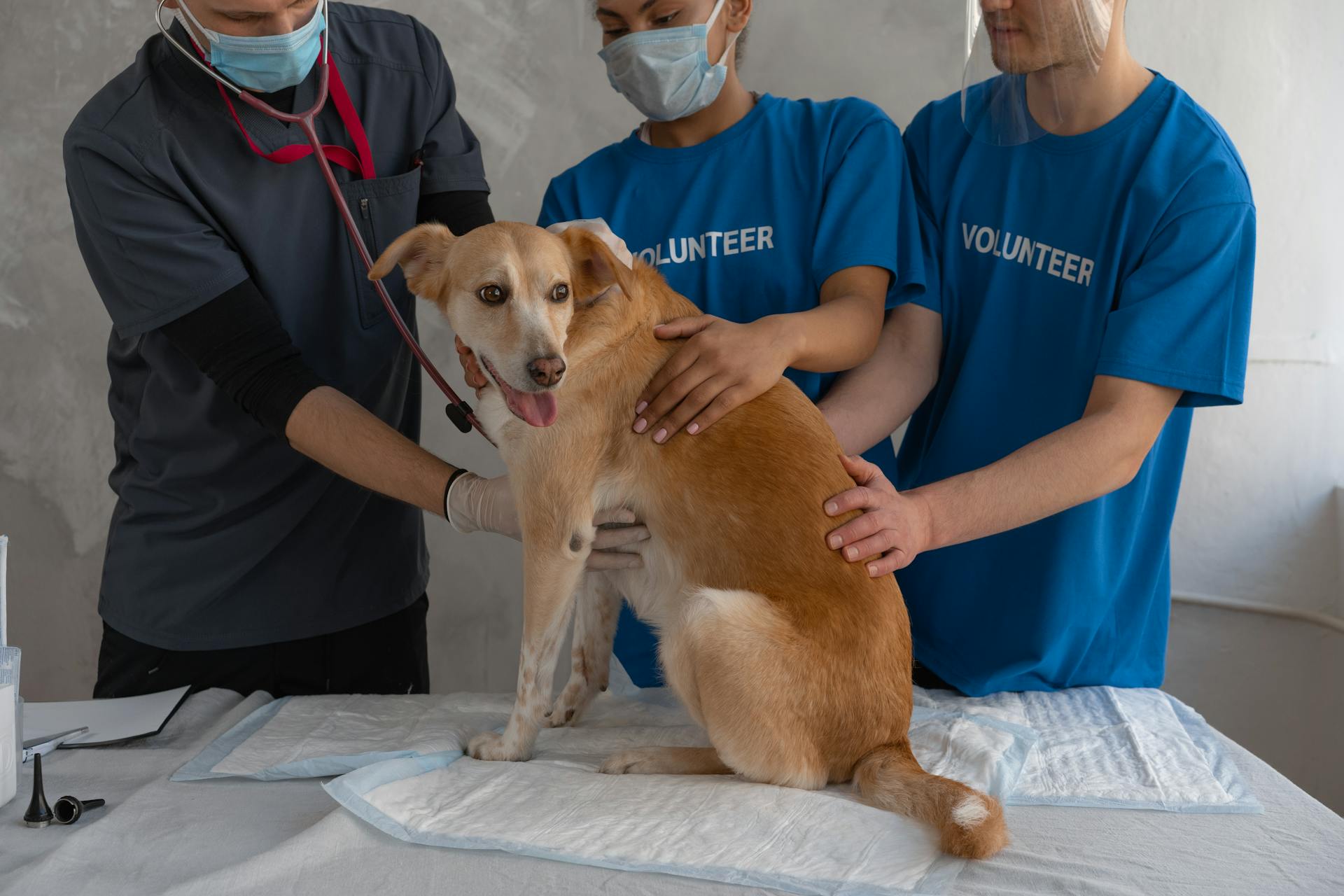
Canine distemper virus is a highly contagious and potentially deadly disease that affects dogs. It's a major concern for dog owners, and understanding the basics can help keep your furry friend safe.
The virus is caused by a highly contagious and mutable virus that can be airborne, making it easily spread. It's often spread through the air when an infected dog coughs or sneezes, and can also be transmitted through direct contact with an infected dog's saliva, urine, or feces.
Symptoms of canine distemper virus can vary, but they often include fever, vomiting, diarrhea, and a distinctive cough. In severe cases, it can lead to seizures, paralysis, and even death.
Prevention is key, and making sure your dog is up-to-date on their vaccinations is crucial.
If this caught your attention, see: How Long Is Kennel Cough Contagious after Antibiotics
What Is Distemper?
Distemper is a highly contagious and potentially lethal disease that affects dogs. It's caused by a paramyxovirus, which is closely related to the measles and rinderpest viruses.
Veterinarians consider the distemper vaccine to be a core vaccination, along with other essential vaccines. This means it's crucial to keep your dog up-to-date on their vaccinations to protect against distemper.
The distemper virus attacks multiple body systems, resulting in a widespread infection that's difficult to treat. This is why it's essential to catch the disease early and seek veterinary care immediately if you suspect your dog has distemper.
Causes and Risk Factors
Dogs are most commonly infected with canine distemper virus when they're exposed to air containing droplets of the virus, usually from an infected animal's cough, sneeze, or bark.
The virus can also be transmitted through direct contact with infected dogs or other bodily fluids, such as saliva, urine, or feces. This means that even a simple interaction with an infected dog can put your own dog at risk.
Infected dogs become contagious to other dogs several days before they show any signs of illness, which can vary from less than a week up to six weeks. This is a critical factor to consider when it comes to preventing the spread of the virus.
Unvaccinated dogs and puppies under 4 months old are particularly susceptible to canine distemper, making them a higher risk group. If your puppy shows any symptoms of distemper, call your vet immediately to get them the help they need.
You might enjoy: Can Dogs Catch Herpes Virus from Humans
Diagnosis and Detection
Diagnosing canine distemper virus (CDV) can be challenging, but there are several tests that can help determine the presence of the virus. A PCR test is considered the current test of choice to detect the virus's genetic material.
A quantitative PCR test is particularly useful as it can determine the amount of virus detected, also known as the viral load. This information can be valuable in interpreting test results and determining if a positive result could be related to recent vaccination.
Veterinarians may also recommend blood work or chest X-rays to assess the overall health of affected dogs and investigate any contributing or secondary infections. High antibody levels paired with a negative PCR result indicate that a dog is likely immune to infection.
Here are the key considerations for collecting and submitting samples for respiratory pathogen PCR testing:
- Collecting samples from dogs exhibiting clinical signs of disease as early in the course of infection as possible and before starting antibiotics.
- Following a proper sample collection technique to ensure accurate test results.
- Selecting a PCR panel that includes quantitative distemper results will provide information about the amount of virus detected (also known as viral load).
A complete necropsy with appropriate sample collection can be the most efficient and reliable means to definitively diagnose CDV in an individual animal or population.
Diagnosis
Diagnosis can be a challenge when it comes to CDV, as the clinical signs can be similar to other common diseases. A PCR test is a diagnostic tool to determine the presence of the virus's genetic material, and a quantitative PCR is considered the current test of choice.
To confirm an infection, veterinarians may use PCR or virus isolation tests. These tests can also determine if recovered dogs are likely to be still infectious to other dogs.
Blood work or chest X-rays may be recommended to assess the overall health of affected dogs and investigate any contributing or secondary infections. This is especially important for older dogs that develop distemper encephalomyelitis.
A brush border slide of the bladder transitional epithelium can be used to confirm distemper in older dogs. This involves staining the inside lining of the bladder with Diff-Quik, which can reveal inclusions that stain a carmine red color.
Explore further: Canine Bladder Cancer Symptoms

In the early stages of distemper, about 90% of bladder cells will be positive for inclusions. This test can be a useful tool for veterinarians to diagnose distemper in older dogs.
To diagnose CDV, a respiratory PCR panel is often used. This test involves collecting nasal, deep pharyngeal, and conjunctival swabs to detect viral nucleic acid. However, positive results can be difficult to interpret due to potential false positives from recent vaccination with a modified live distemper vaccine.
A veterinarian familiar with the shelter population should interpret results to ensure accurate diagnosis. To collect accurate samples, it's essential to follow a proper sample collection technique and select a PCR panel that includes quantitative distemper results.
Here are some key considerations for collecting and submitting samples for respiratory pathogen PCR testing:
- Collect samples from dogs exhibiting clinical signs of disease as early in the course of infection as possible.
- Follow a proper sample collection technique to ensure accurate test results.
- Select a PCR panel that includes quantitative distemper results to determine the viral load.
If dogs die or are euthanized, a complete necropsy with appropriate sample collection can be the most efficient and reliable means to definitively diagnose CDV.
Identify Sick Animals
Daily rounds are key to recognizing signs of illness in individual animals.
Increased frequency, severity, or duration of Canine Infectious Respiratory Disease Complex cases can indicate a potential issue.
Sudden death, particularly in puppies, is a red flag that warrants immediate attention.
Gastrointestinal signs, such as vomiting and diarrhea, combined with Canine Infectious Respiratory Disease Complex signs, are a cause for concern.
Neurological signs, including seizures and muscle tremors, can also indicate a serious health issue.
If you notice any of these signs, it's essential to take prompt action to prevent the spread of disease and ensure the animal receives proper care.
Suggestion: Canine Lupus
Symptoms and Stages
Canine distemper virus (CDV) is a serious and potentially life-threatening disease in dogs. It's essential to recognize the symptoms and stages of the disease to provide prompt treatment and care.
The first symptom of distemper in dogs is usually watery to pus-like discharge from their eyes, followed by fever, loss of appetite, and clear nasal discharge. This can happen as early as 3-to-6 days after being infected.
Worth a look: Canine Distemper Eye Discharge
Fever, clear nasal discharge, purulent eye discharge, lethargy, coughing, vomiting, diarrhea, and pustular dermatitis are common symptoms associated with distemper in dogs during the first stages of infection.
As the disease progresses, some dogs develop neurological signs, including head tilt, circling, partial or full paralysis, seizures, nystagmus, muscle twitching, and convulsions with increased salivation and chewing motions.
Distemper in dogs can lead to secondary bacterial infections, which can cause respiratory and GI symptoms such as vomiting, diarrhea, difficulty breathing, change in respiratory rate, and pneumonia.
Here's a breakdown of the two stages of symptoms associated with distemper in dogs:
It's worth noting that some dogs may develop hyperkeratosis of the paw pads and nose, giving distemper the nickname "hard pad disease." This can cause the pads of a dog's feet to harden and enlarge, leading to discomfort.
Treatment and Management
Canine distemper virus is a serious and potentially life-threatening illness in dogs. There is no specific treatment or cure for the virus, and treatment is focused on managing symptoms and preventing secondary infections.
Supportive care is the mainstay of CDV treatment. This includes intensive nursing care, fluid replacement, and nutrition.
Antibiotics are often used to protect dogs with weakened immune systems from secondary bacterial infections. IV fluids are also used to prevent dehydration.
Dogs with mild neurological cases may be treated with anti-seizure medications. However, in severe or unmanageable cases, humane euthanasia may be the best option.
The survival rate and length of infection depend on the strain of the virus and the strength of the dog's immune system. Some cases resolve as quickly as 10 days, while others may exhibit neurological symptoms for weeks or even months.
Here are some common treatments used to manage CDV symptoms:
- Antibiotics
- IV fluids
- Palatable, easy to digest food
- Anti-nausea medications for GI symptoms
- Anti-seizure medications in mild neurological cases
- Humane euthanasia for severe or unmanageable cases
Prevention and Control
Prevention and control of canine distemper virus (CDV) are crucial to prevent the spread of the disease. The most effective way to prevent CDV is through vaccination.
Puppies should start receiving the CDV vaccination at 6-8 weeks of age, with booster shots every 3-4 weeks until they are 16-20 weeks old. The vaccine is then repeated after 1 year and generally every 3 years after that.
Related reading: Canine Parvovirus Prevention
Infected dogs must be identified and isolated from other dogs to prevent further spread of the virus. Caretakers should wear disposable personal protective equipment (PPE), including gowns, gloves, and booties, when interacting with the infected dog or cleaning their space.
Good hygiene and thorough cleaning are essential in preventing the spread of CDV. Most household disinfectants can easily kill the virus, and routine sanitation protocols are generally adequate to prevent the spread of CDV in the environment.
Here's a summary of the vaccination schedule for puppies:
Dogs that are not vaccinated may still be susceptible to CDV infection, so it's essential to keep them away from infected animals and wildlife. By following these guidelines, you can help prevent the spread of CDV and keep your furry friend safe.
Frequently Asked Questions
What can be mistaken for distemper?
Kennel cough can be mistaken for canine distemper due to similar respiratory symptoms. Other conditions like parvovirus, coronavirus, and internal parasite infections can also present similarly, requiring a differential diagnosis
How long will a dog live with distemper?
Dogs with distemper typically live for 2-4 weeks before reaching the terminal stage, but some may survive for months with the illness. The exact duration depends on various factors, including the dog's age and overall health.
How long can a dog live with canine distemper?
Dogs with canine distemper can live for several months before symptoms appear, but typically reach the terminal stage within 2-4 weeks. The duration of survival varies depending on the dog's age and overall health.
What kills distemper viruses?
Distemper viruses can be easily eliminated with disinfectants, sunlight, or heat. Effective elimination methods can help prevent the spread of this highly contagious disease.
Is canine distemper highly contagious?
Yes, canine distemper virus (CDV) is highly contagious and can spread quickly in areas with low vaccination rates and high dog populations.
Sources
- https://www.vet.cornell.edu/departments-centers-and-institutes/riney-canine-health-center/canine-health-information/canine-distemper-virus
- https://www.akc.org/expert-advice/health/distemper-in-dogs/
- https://en.wikipedia.org/wiki/Canine_distemper
- https://www.merckvetmanual.com/dog-owners/disorders-affecting-multiple-body-systems-of-dogs/canine-distemper-hardpad-disease
- https://www.aspcapro.org/resource/canine-distemper-virus
Featured Images: pexels.com


